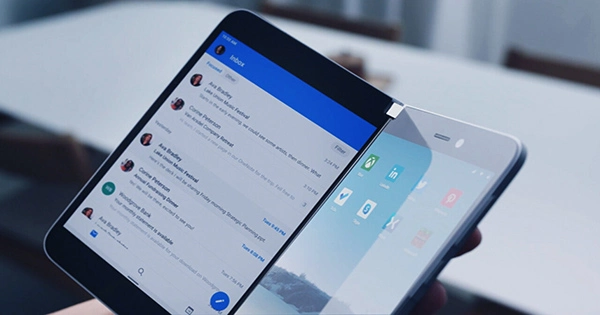Those familiar with Microsoft’s intentions told me that the company’s upcoming foldable Surface phone won’t have two screens. The business has opted to go to a more conventional foldable design with a 180-degree hinge, internal foldable screen, and external cover display, akin to devices like the Vivo X Fold and Honor Magic Vs, after a long year of hardware research and experimentation. (new tab opens)
According to what I’ve been informed, the firm had already decided on a dual-screen layout for the Surface Duo 3 when this new foldable gadget was created. The original Surface Duo, with its edge-to-edge displays that were larger and slimmer, wireless charging, and other upgrades, was scheduled to debut at the end of 2023.
The Surface team is now concentrated on delivering this new “true” foldable design as the dual-screen idea has been abandoned. After the Surface Duo 2 launched and received unfavorable reviews, Microsoft started looking into single-screen foldable designs as a potential replacement.
It’s still too early to tell what exact hardware specifications this new foldable gadget will have, or if Microsoft intends to imitate a dual-screen experience via a software function or mode. It seems improbable that the device will be available in time for this fall, according to my sources, who also claim that there is no firm shipment window in place for it yet.
The next Surface Duo may pivot to one of Microsoft’s recently-filed design patents for single-screen foldables with a 360-degree hinge, according to some rumors. According to my sources, this is untrue, and the foldable gadget will really have a 180-degree hinge like the majority of foldable phones.
Of course, a name change could accompany a change in form factor. Although it’s too soon to tell, considering that this device doesn’t have the typical form factor of a Duo, it’s possible that the manufacturer will use this as an opportunity to rename the series, much like it did with the Surface Book and Surface Laptop Studio. However, according to my sources, this device is still internally regarded as a third-generation Duo.
Additionally, according to my sources, Google is working internally on a larger software project to better set its future Android hardware products apart from those of its rivals. The “Perfect Together” initiative intends to create an ecosystem between Microsoft’s Android hardware and Windows PCs that is comparable to that of an iPhone and a Mac.
Aside from a foldable handset, I’ve also heard that Microsoft is anxious to diversify its selection of Android smartphones and has been looking into other form factors. While nothing is definite, I’m informed that the business has already prototyped a number of conventional slab smartphone designs that may be sold as a “mainstream” Surface phone option, leaving the foldable device to be an enthusiast item.
Overall, Microsoft’s Android efforts have undergone substantial modifications and ambitions, and according to my sources, the company is still “all-in” on producing its own Android hardware and software. Just let’s hope the upcoming Surface phone is ready as soon as possible.
















